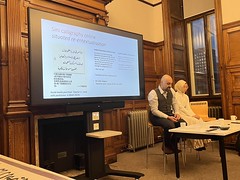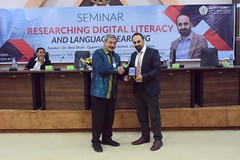I had a fascinating session with Cathy Clarkson yesterday, where we performed a digital literacies “icon mapping” exercise with the students of her very innovative “L4 Technology for Learning Delivery” course. I have been observing the course as part of my PhD research, and we agreed to use part of our session to adapt an ‘icon mapping’ exercise that I’ve used before to explore my participants’ digital literacy practices across different aspects of their professional, personal, and study life contexts.
The idea of icon-mapping is a participatory, interactive, and visual qualitative method of interviewing in social research. It allows a researcher to augment and add to a conventional qualitative research interview, and is also useful for reflexive class discussions, allowing participants to reflect on what digital tools they use in different aspects of their lives, how such practices ‘flow’ across apparent boundaries, and to trace where the flows occur to and from. It allows the participant to create a visual representation of this process.
The basis of its use here was as a Venn diagram of digital media usage across the contexts of social, college, and work spheres and the cross over between these focal points. An interview process of this kind, involving icon mapping and diagram creation, has been substantiated in notable research in the field of Literacy Studies. In The Literacies for Learning in FE project, the focus was on the multitude of complex and sophisticated ‘literacies’ that people practice in their personal and professional lives, and how these can be tapped in to, mobilised, or harnassed as resources when it comes to the ‘literacies’ of the classroom. Students’ creative ways of “translating” (Bowker and Star, 1999; Latour, 1993) between networks, causes these ostensibly separate domains to flow together through the multilayered nature of digital literacy practices. It is a kind of ‘boundary crossing’ to deploy a phrase from Ivanič and Satchwell (2007). The relationship, therefore, between domains and digital literacy practices is complex and messy, and so we asked the participants to trace the flows of these practices and digital media use by scribbling, annotating, and amending the diagram as they see fit. The messier the Venn diagram, the better. The results were interesting:

Some of the participants’ digital media use flows from work-based practices, then infiltrates their personal lives. Discussions revealed a range of possible reasons for this: initiatives and diktats at work which then get implemented at home for convenience, etc. This is in contrast to one particular case-study of some previous research I have done where I have seen how students’ home or personal digital media use can infiltrate their study and work practices, allowing them to capriciously circumvent institutional policies.

Some, albeit a minority, successfully make the link between their own everyday digital literacy practices and the requirements of their course or work and managed to converge as many elements as they could. For example, using one email to manage all other emails, or using cloud-based storage services for family and work use.
Others, also a minority, insisted on separately demarcating these domains as if they ought not to be connected, and using separate accounts of social media platforms for home/work/study.
Monitoring the flows of practices across our lives in this way means that we may need to go beyond a Venn diagram–or other geometric–depiction of ‘context’ and ‘border’ when looking at literacies, especially in the co-presence afforded by the digital space. Such a highly complicated space and practices may involve us imagining “a change of topology” (Latour, 1997), where “[i]nstead of thinking in terms of surfaces – two dimension- or spheres -three dimension- one is asked to think in terms of nodes that have as many dimensions as they have connections” (Ibid, 1997: 2).
BOWKER, G. C. & STAR, S. L. (1999). Sorting things out : classification and its consequences, London: MIT Press.
IVANIČ, R. and SATCHWELL, C. (2007) ‘Boundary crossings: Networking and transforming literacies in research processes and college courses’, Journal of Applied Linguistics, Vol. 4, No. 7.
LATOUR, B. (1997). The Trouble With Actor-Network Theory [Online]. Available: http://www9.georgetown.edu/faculty/irvinem/theory/Latour-clarifications.pdf
Categories: Digital Literacies, Methods, PhD Reflections, Technologies













2 replies »